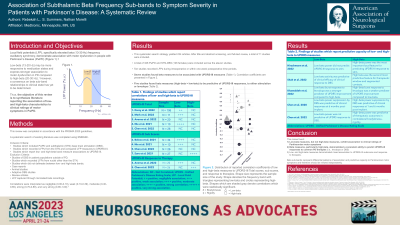Association of Subthalamic Beta Frequency Sub-bands to Symptom Severity in Patients with Parkinson’s Disease: A Systematic Review
Friday, April 21, 2023


Rebekah L. Summers, DPT, PhD (she/her/hers)
Principal Clinical Scientist
Medtronic
ePoster Presenter(s)
Introduction: Beta (13-30Hz) frequency measures have been found to be associated with motor dysfunction in patients with PD undergoing deep brain stimulation (DBS). Low-beta may be more responsive to medication states and express stronger association to motor dysfunction in PD compared to High-beta. However, a consensus on beta sub-band relationships to clinical state has yet to be determined. Therefore, our objective was to synthesize existing literature regarding the association of beta sub-band local field potential (LFP) characteristics to clinical ratings of motor symptoms in patients with Parkinson’s disease (PD).
Methods: A systematic search of existing literature was completed using EMBASE. Articles which collected subthalamic nucleus (STN) LFPs using macroelectrodes in patients with PD, analyzed low- (13-20 Hz) and high-beta (21-35 Hz) bands, collected UPDRS-III measures, and reported correlational strength or predictive capacity of LFPs to UPDRS-III scores. Articles were screened by title and abstract prior to undergoing full-text review for inclusion and data extraction.
Results: The initial search yielded 233 articles. After screening and full-text review, 10 articles, with a total of 300 patients, were included. Beta measures included power spectral density, peak characteristics, and burst characteristics. Eight (80%) articles found low-beta and six (60%) found high-beta to be significantly correlated with, or predictive of, UPDRS-III scores or response to therapy. Four (40%) articles found both low- and high-beta to be associated with, or predictive of, UPDRS-III sub-scores or response to therapy. However, only one of the four found that high-beta had a stronger association to symptom severity compared to low-beta.
Conclusion : This systematic review suggests that low-beta measures represent a biomarker of Parkinsonian symptom severity in patients with STN-DBS to a greater capacity than high-beta measures. Interestingly, these associations were found across multiple LFP measures, suggesting multiple analytical approaches using LFP signals can still yield clinically meaningful biomarkers of patient clinical state.
Methods: A systematic search of existing literature was completed using EMBASE. Articles which collected subthalamic nucleus (STN) LFPs using macroelectrodes in patients with PD, analyzed low- (13-20 Hz) and high-beta (21-35 Hz) bands, collected UPDRS-III measures, and reported correlational strength or predictive capacity of LFPs to UPDRS-III scores. Articles were screened by title and abstract prior to undergoing full-text review for inclusion and data extraction.
Results: The initial search yielded 233 articles. After screening and full-text review, 10 articles, with a total of 300 patients, were included. Beta measures included power spectral density, peak characteristics, and burst characteristics. Eight (80%) articles found low-beta and six (60%) found high-beta to be significantly correlated with, or predictive of, UPDRS-III scores or response to therapy. Four (40%) articles found both low- and high-beta to be associated with, or predictive of, UPDRS-III sub-scores or response to therapy. However, only one of the four found that high-beta had a stronger association to symptom severity compared to low-beta.
Conclusion : This systematic review suggests that low-beta measures represent a biomarker of Parkinsonian symptom severity in patients with STN-DBS to a greater capacity than high-beta measures. Interestingly, these associations were found across multiple LFP measures, suggesting multiple analytical approaches using LFP signals can still yield clinically meaningful biomarkers of patient clinical state.
